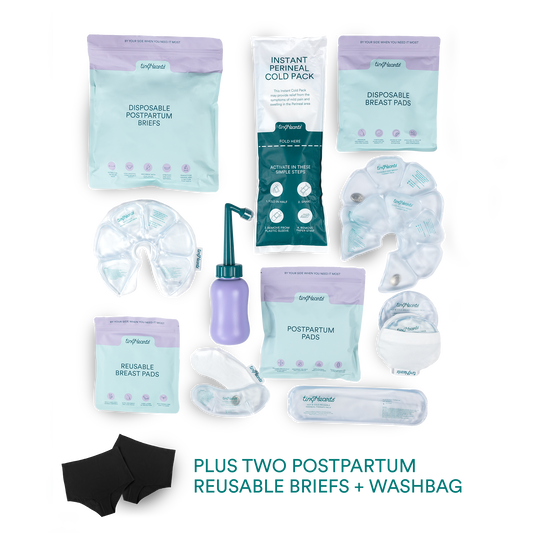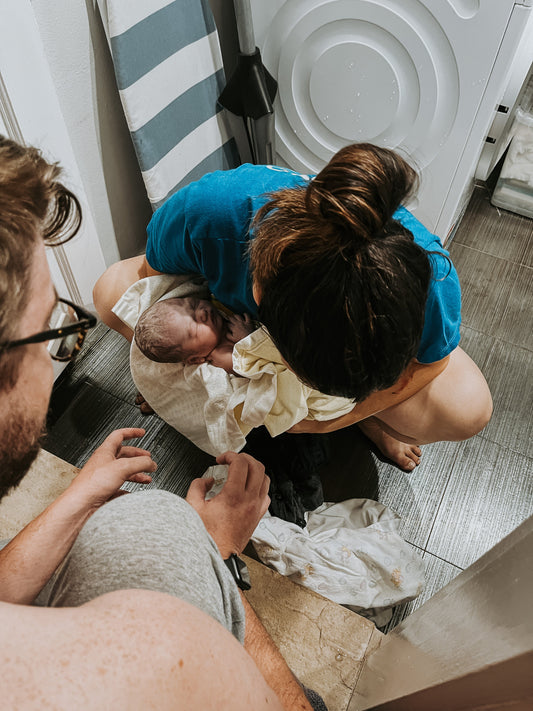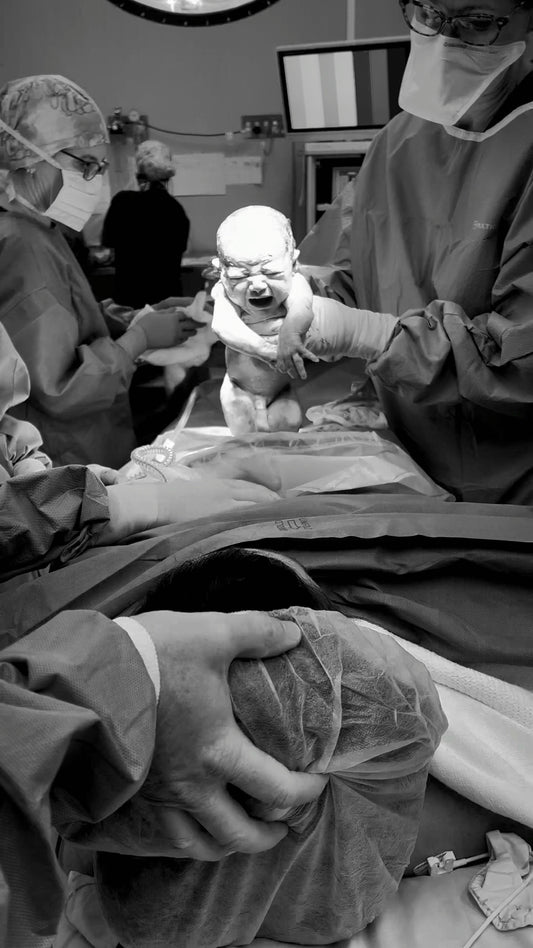labour + birth complications explained
Written by Jade | Midwife, Mama of 3 & Tiny Hearts Educator
Sometimes, labour and birth go perfectly with no complications. But as you're probably aware or have heard by now, birth doesn't always play out that way. In this blog, we're going to cover some of the more common labour and birth complications that you might hear about or know of, keeping in mind that although these are more common, they are still relatively uncommon and your birthing team are very well trained to identify + manage complications that may arise.
Postpartum Haemorrhage
Blood loss after birth, which is called 'lochia', is completely normal and expected. After birth, you can expect to lose up to 500mls of blood as this is still considered normal. The definition of a postpartum haemorrhage according to RANZCOG guidelines is traditionally blood loss of 500ml or more during puerperium and severe PPH as a blood loss of 1000ml or more. More recently symptoms of large amounts of blood loss are also taken into account when defining "severe" postpartum haemorrhage regardless of the amount of blood.
where does the bleeding come from?
There are 4 sources of bleeding that can occur after birth that may be responsible for the PPH known as the 4 T's; tone, trauma, tissue, and thrombin.
TONE: When your placenta comes away from your uterus after birth, the blood vessels that supplied blood to the placenta are still open, causing them to bleed until your uterus contracts down. If the uterus isn't contracting down on itself and becomes a bit floppy, these vessels aren't contracted as well as they should be, meaning they will bleed, and the uterus could begin to collect blood, or it may gush or trickle out constantly. 'Tone' is thought to be responsible for up to 70% of all PPH's worldwide. TRAUMA: For vaginal births, blood may also come from vaginal or cervical tearing, an episiotomy or a haematoma [bleeding into hidden tissue or space, usually in the vaginal or vulval area, which is extremely painful]. In some cases, a blood vessel may be in the area where the tear occurred, which can increase bleeding quickly.
TISSUE: 'Tissue' links back to the 'tone' point. If there is part of the placenta or membranes still left in the uterus, it can't clamp down on itself as much as it needs to and can become floppy. This one links back to the 'tone' point. If the uterus is becoming floppy, it will bleed as the blood vessels in the uterus aren't clamped off.
THROMBIN: This one is usually less likely than the other three and may be in part caused by some conditions such as HELLP syndrome. It refers to a problem with the clotting factors in a mama's blood, causing delayed or reduced ability to clot the blood to stop the bleeding.
what's not normal bleeding?
- Soaking more than one pad an hour during the first day
- Soaking more than one pad every two hours after the first day
- Bleeding increases suddenly or you pass large clots [keep them to show a midwife who will check it's not part of the placenta]
- Bleeding returns to bright red after changing to pink or brown
- You feel faint, dizzy, light-headed, weak or have trouble breathing
- Your bleeding smells or is an unusual colour
- You are worried you are bleeding too much or that it isn't normal
For more info on a PPH including what your birthing team will do to stop the bleeding, head to our blog on Postpartum Haemorrhage.
Shoulder dystocia
Shoulder dystocia is a rare emergency that happens during birth. It happens in about 1 in 150 vaginal births.
Shoulder dystocia is when bub's head is born, but one of the shoulders become stuck behind a mama's pubic bone [the bone above your vagina used to measure how big your belly is growing]. Because the shoulder is stuck, bub's body won't birth without extra help from your birthing team. Shoulder dystocia can't be prevented in most cases.
Fun fact: half of all shoulder dystocia happens to bubs weighing less than 4kg!
Third and fourth-degree tears and postpartum haemorrhages are more common for mamas after shoulder dystocia, while some bubs will have a fractured arm or shoulder. Around 1 in 10 will experience stretching of the nerves in the neck called a brachial plexus injury [usually temporary- permanent damage is rare]. In very rare cases, bub may be without oxygen for too long while stuck, leading to brain damage.
Let's be clear; this is an EMERGENCY. If this happens, your midwife will hit the emergency bell, and many people will come into your room. Next, your birthing team will try several manoeuvres to deliver bub as quickly and safely as possible.

cord prolapse
A cord prolapse is a medical emergency. It's when your bub's cord is in front of, or beside, bub's body part that is closest to the exit [presenting] when your waters have broken. If your waters are not broken, but bub's cord is in front of or next to the presenting part, this is called a cord presentation.
A cord prolapse/ presentation only occurs in 0.1-0.6% of births but can have devastating impacts because the cord is bub's oxygen supply.
risk factors
Some factors put you at a higher risk of a cord prolapse:
- Bub's head/ presenting part is high [not engaged]
- You're preterm
- You have higher levels than normal of amniotic fluid
- There's more than one bub in your tummy
- You've had lots of bubs before
- Bub's head isn't closest to the exit
treatment
If there are abnormal changes in bub's heart rate during labour, particularly after breaking your waters, your birthing team may recommend a vaginal assessment to rule out a cord prolapse. If they do feel a cord, there's a lot that will happen. They will:
- Initiate an obstetric emergency by pressing the emergency buzzer
- Lots of staff will run in, and people may begin preparing you for a quick transfer to theatre.
- You might also be asked to roll onto your tummy and put your knees to your chest, lay on your left side or upside down [deep Trendelenburg position].
- Your birthing team may continue with the vaginal assessment to attempt to keep bub's cord from being compressed.
- Stop the hormone drip [and potentially give you medication to stop contractions if birth via c-section or instrument isn't going to happen immediately].
- Pop an oxygen mask on you.
- Ask you lots of questions in preparation for theatre and answer any questions you might have on the way.
- Push your bed to theatre.
- Call the theatre team, obstetric team, paeds team and document.
Regardless of the setting, cord prolapse is an emergency. If you experience a cord-prolapse at home [rare], roll onto your tummy, with your chest to your knees and bum in the air, and call 000.
preterm labour
Preterm labour is when a mama begins contracting, and the cervix begins changing [opening, softening, moving to the front + thinning out] before 37 weeks in pregnancy. Preterm labour + birth is classified in severity based on how pregnant you are at the time of bub's birth:
Less than 28 weeks = extremely preterm
28 - 32 weeks = very preterm
32 - 36+6 weeks = moderate to late preterm
Sometimes there's no obvious cause for preterm labour, but there are certain factors that can increase the likelihood of bub being born preterm, such as being pregnant with more than one bub [twins, triplets etc.], bleeding from the placenta or the cervix opening or changing during pregnancy.
In some cases, it may be recommended that bub is purposely born early by induction or a c-section, such as bub isn't growing on ultrasound, there are signs of infection developing in bub's sac +
mama is bleeding from the placenta.
Signs + symptoms
Signs + symptoms of preterm labour are similar to that of labour at full term, which may include:
- Lower abdo cramps
- Back pain that comes + goes
- Your whole belly goes tight, accompanied by discomfort in your belly or back
-A heavy feeling/ lots of pressure in your vagina or rectum
- Diarrohea, nausea + vomiting
- Losing your mucous plug/ a bloody show
- 'Braxton Hicks' becoming painful, regular + closer together
Some mamas report that their preterm labour contractions didn't begin as intense as what occurred when they laboured at full term, so if you see any of these signs, it's important to reach out to your OB or Midwife for individualised medical advice.
For more info, including what happens if you turn up at the hospital in preterm labour, check out our blog all about preterm labour.

obstructed labour
Obstructed labour is when labour is not progressing as normally expected. This may be during the first stage [contractions] or during the second stage [pushing]. This is different to a Deep Transverse Arrest, which is when bub's birth isn't progressing because the head isn't coming any lower, and they're not rotating their body as normally expected once their head reaches a certain point in a mama's pelvis.
Signs of obstructed labour
- No cervical changes over many hours despite strong, painful + regular contractions
- A mama develops a fever Blood may be seen in the urine
- A mama's heart rate is increasing
- Bub's heart rate is showing changes
- Bub's not descending lower into the pelvis
- The cervix may swell
- Bub's head may develop some swelling
While there are many potential causes of obstructed labour, some include bub's in a position that isn't optimal for birth and isn't moving, the shape of your pelvis [there are 4 different shapes of pelvis' and not all are optimal for birth] or bub's head may be too big in comparison to your pelvis.
If your birthing team believe you're beginning to show signs of obstructed labour, they may recommend various things such as a CTG [continuous monitoring], some fluid through a drip, potentially starting a drip of medication to bring on or making more contractions, and to make them stronger, emptying your bladder or a caesarean section.
concerns about bub's heart rate
During your labour, bub will be monitored either using a doppler every 15-30min during the contraction phase and at least every 5 min during the pushing phase. If you've got a risk factor, you may be recommended to have a CTG during labour + birth [continuous monitoring].
If concerning heart rate changes are picked up on the doppler, your birthing team may recommend a CTG to have a closer look at what is going on with bub. On the CTG, bub may be dropping their heart rate. This could be a result of their head getting squished, the cord being temporarily compressed or bub becoming stressed. Depending on numerous factors such as what is happening with you + your body, how far along you are in labour, what number baby etc, the team may recommend taking trying some other things such as the hormone drip or position changes, they may recommend taking some blood from bub's head to test to see how stressed they are or may even recommend a c-section.
severe tears
If you tear during a vaginal birth, it will be classified based on the depth of the tear and which part of your vagina or bottom has torn. Let's break it down so you can understand more about your tear.
The area between your vaginal opening and anus is known as the 'perineum'. When the perineum tears, the classifications are: 1st degree, 2nd degree, 3rd degree [3A, 3B or 3C] + 4th degree
1st degree tear
1st-degree tears are shallow and involve the skin layer only. If the area comes back together easily and is not bleeding, it generally won't require stitches. However, in some cases, stitches may still be recommended.
2nd degree tear
2nd-degree tears involve the skin and muscle layer of the perineum. Evidence suggests that 2nd-degree tears heal better when sutured, so these will be sutured in the large majority of cases.
3rd degree tear
A 3A tear is when the tear has gone through the skin, perineal muscle and less than 50% of the external ring-shaped muscle surrounding the anus, called the anal sphincter. A 3B tear is when a tear goes through the skin and perineal muscle and has torn more than 50% of the external anal sphincter, but the internal anal sphincter remains intact. 3C tears occur when a Mama tears through the skin, perineal muscle, internal and external sphincter, but the rectum remains intact.
4th degree tear
A 4th-degree tear occurs when the tear extends through the skin, perineal muscle, anal sphincter and all the way into the rectum.
Sometimes, a mama may tear the other way. This can result in labial tears or grazes [that absolutely sting when you wee], urethral tears [which may result in you having a catheter inserted during repair and potentially for a little while afterwards] + clitoral tears [which can be extremely painful].

meconium liquor
Meconium is your bub's first poo. It's black/ dark green, thick, sticky and super messy.
Meconium is made up of cells, fats, proteins and intestinal secretions like bile. It collects in the intestines from around week 12 in pregnancy and comes out as bub's first poo, usually after birth. In some cases, a bub will poo while still in utero, which turns the amniotic fluid a green or yellow colour and is known as meconium-stained liquor.
Meconium liquor is more common if you are overdue or pre-eclamptic, use drugs, have placental insufficiency or too little amniotic fluid, or bub has experienced distress in utero. If your waters break, and you see a yellow or green colour, contact your birthing team. If it occurs during labour, your birthing team will recommend a CTG to monitor bub for signs of distress. After birth, bub will have regular observations to monitor for complications from the meconium-stained liquor.
Sometimes babies have meconium-stained liquor, and they are born perfectly, with no complications after birth. Others will go onto experience meconium aspiration syndrome [MAS], which can be dangerous, and in rare cases, deadly.
MAS occurs when a newborn has difficulty breathing because meconium is present in the lungs. The meconium may physically block the airway and cause inflammation in the lungs. If your bub is showing signs of MAS [blue colour, fast breathing, unusual breathing sounds, increased work of breathing, fever or a barrel-shaped chest], your bub's doctors may order some tests. The tests may include oxygen saturation levels, an echocardiogram and a chest x-ray. If your baby has MAS, they will be admitted to NICU for treatment and ongoing monitoring. Bub may need antibiotics, oxygen, IV lines, medication like artificial surfactant, intubation and ventilation.
abruption
Placental abruption is the most common cause of bleeding during the second half of pregnancy. It happens during pregnancy or labour when some or all of the placenta comes away from the wall of the uterus. Trauma, such as falling onto your bump or a car accident, may cause a placenta abruption, but sometimes the cause is unknown.
signs + symptoms
The symptoms for placenta abruption are different for everyone, but generally, most women experience:
- Constant abdominal pain, which may be mild or severe in the tummy or back.
- Bleeding. Most mamas will bleed with an abruption, but the amount of blood doesn't indicate how severe the abruption is. Some mamas won't lose any blood because some [or all of] the blood may be trapped behind the placenta.
If you think you're having a placental abruption, you need to immediately contact your pregnancy care team. If you experience sudden, severe abdominal pain and heavy bleeding, call 000 for an ambulance. [Don't forget, you don't have to see blood to be having an abruption].
Your placenta is your bub's oxygen source, meaning a placental abruption can be a life-threatening emergency, depending on how much has abrupted. Some mamas who have had a partial abruption, with the right pregnancy care, can continue on to have a full-term pregnancy. Other mamas will need bub to be born immediately. Your birthing team will have that discussion with you.

red flags
As always, if you ever see any the pregnancy red flags, it's so important to call your OB or Midwife straight away and seek medical attention, such as:
- Bleeding, even if it's painless
A change in bub's movements
- Contractions before 37 weeks
- Visual disturbances
- Severe itching Significant swelling, particularly if it involves more than the hands and feet
- You're concerned
I hope that helps you understand some more common labour + birthing. If you've got any more Q's or are unsure, book into our Bump, Birth + Beyond course for all things pregnancy, labour and birth and postnatal related. On the original post, tag a loved one and let me know; did you or someone you know experience one of these conditions? 🤍
bump, birth and beyond
$199
The Bump, Birth & Beyond course will educate you and your co-pilot (support person) on what to expect during pregnancy, birth and the first trimester with your new little love.









